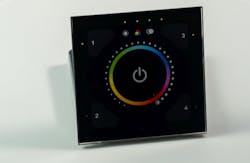Helvar adds touch-wheel for circadian lighting control
Finnish LED company continues to build up its stable of IoT and human-centric products.
Finland's Helvar continues to expand its stable of circadian lighting products, this time adding a wired touch panel control wheel that allows users in a single office to change color temperature and brightness.
Interested in articles & announcements on circadian lighting & controls?
The Illustris Power panel uses the DALI (digital addressable lighting interface) protocol to connect to lights in meeting rooms, boardrooms, open plan space, or elsewhere. It includes four preset levels but also lets users dial up a specific brightness or color temperature. For color temperature, users run their finger to the corresponding color on the wheel (see the nearby photo), which comes in black or white and with a glass or plastic face.
Illustris also lets users adjust settings via a wireless Bluetooth connection from a smartphone app.
The idea of circadian lighting, also called human-centric lighting, is to set lighting levels to different frequencies — color temperatures — that conform to the human circadian rhythm. Generally speaking, warm amber colors — associated with dusk— provide relaxation, and colder bluish colors — associated with daytime — stimulate. It is a concept that is beginning to catch on in offices, schools, healthcare settings, and in other environments. In one recent implementation, the SAS lounge at Oslo Airport is offering circadian lighting areas to help passengers relax or stay awake. Human-centric lighting is driving industry-wide product developments such as the new wellbeing dashboard from amBX.
The Illustris Power panel for circadian lighting control allows four presets and also lets the user dial up a specific light temperature and brightness. (Photo credit: Helvar.)
“Multiple studies have shown that our emotional wellbeing, comfort, and productivity can be enhanced through the correct control of artificial lighting to mirror our circadian rhythm,” said Pietari Tuomisto, product owner, embedded products at Helvar. “By manipulating scenes, color temperatures, and intensities, this human-centric lighting can ensure the right light for the time of day and to suit different tasks that will energize our space.”
Helvar, based in Espoo outside of Helsinki, has been steadily building up its circadian and smart lighting offerings. Last spring, with human-centric principles in mind, it announced software that lets lighting designers adjust light temperatures and brightness.
It is also participating in an Internet of Things (IoT) trial at Finland's Oulu University, connecting about 100 luminaires to a 5G mobile network to help improve lighting controls and to also help gather information through sensors about facility usage.
To help lead its push into the IoT and smart lighting, the company has been turning to former mobile industry executives for leadership. Last summer, it hired former Nokia executive Adel Hattab as CEO, replacing Hans Henrik Lund, another former mobile and automation industry boss who had joined in September 2016.
MARK HALPER is a contributing editor for LEDs Magazine, and an energy, technology, and business journalist ([email protected]).

Mark Halper | Contributing Editor, LEDs Magazine, and Business/Energy/Technology Journalist
Mark Halper is a freelance business, technology, and science journalist who covers everything from media moguls to subatomic particles. Halper has written from locations around the world for TIME Magazine, Fortune, Forbes, the New York Times, the Financial Times, the Guardian, CBS, Wired, and many others. A US citizen living in Britain, he cut his journalism teeth cutting and pasting copy for an English-language daily newspaper in Mexico City. Halper has a BA in history from Cornell University.





